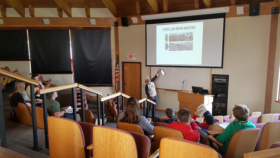
Last week, sixth grade students from T. J. Walker Middle School resumed their work at our Archaeological Dig at The Cove Preserve of Crossroads. The students had begun the dig last fall under the guidance of professionals from Midwest Archaeological Consultants.
Then this winter, the students spent seveal weeks studying native people during their social studies classes. And with their new, the students were more than eager to return to the dig—and to continue making discoveries
Archaeology is considered a branch of the humanities and the truth is, our dig at The Cove is about as low tech as you can get. Students use trowels to scrape soil from the test plots and then sieve the soil through a wire mesh in order to find stone tools, points, flakes, pottery, and animal remains.
But as the students learned this spring, archaeologists also use modern science to learn about life ways of the past. Recently, Crossroads received a grant from the Maihaugen Foundation which will enable us to us to send some of the artifacts found at Crossroads away for laboratory analysis.
Because one of our scheduled dig days was rainy, the students participated in unique indoor activity presented by archaeologist Cassandra Tobin . Students were told that while our grant was generous indeed, the funds certainly could not underwrite all possible tests—-and that the adults had agreed that students should debate the options and we would let them decide which tests to order. The students first participated ” float machine.” experience. Using compressed air, the machine is able to separate rock materials from animal remains such as bones, shells, hair, and fish scales. Students learned that if these animal remains are sent to a lab, they can be analyzed revealing what the people ate, utilized,and what they discarded.
Protein Residue Analysis uses techniques were developed for forensic science. Because proteins are present in all body fluids, scientists can test the blood residue left on weapons to determine whether the blood was from humans or, say, from a rabbit or deer. Blood residue on scrapers can tell us what kinds of animal hides were used for clothing or shelters. The downside of this test that only one in ten specimen yields results.
Ceramic Petography –Thin Section Analysis is a technique by which extremely thin sections of pottery can be analyzed under a polarized light microscope. Because different cultures had distinct pottery making traditions and techniques, and because native people used local materials, thin section analysis can reveal a great deal about communities and trade routes.
An electron microscope is required for Lithic Use-Wear Analysis, Under extremely high magnification, stone tools reveal wear patterns that indicate whether they were used for cutting, scraping, sawing or piercing. Using this technology, scientists can actually tell how tools were utilized by various cultures.
Finally, Radiocarbon Dating is based on the fact that living things absorb carbon which then is slowly released after death. By testing the decrease of Carbon 14 in an organic object, scientists can accurately determine how long ago it lived.
In all six groups of young people, the debate was vigorous and insightful. The adults had predicted that the students would want the Protein Residue test, but the middle school students proved themselves to be fiscally responsible.
Students wanted reliable results and also really wanted to know how long ago native people lived beside Big Creek. Radiocarbon Dating was the near-unanimous first choice…and their somewhat surprising second choice was to have the animal remains, which they captured with the float machine, analyzed in a lab. We will honor the student decisions and now our team of archaeologists will be debating the third choice, which may be determined based on what they find when we open the dig again in June.
Friday and Saturday of Memorial Day weekend, the Collins Learning Center will be closed so that we can participate in the Door County Festival of Nature and the Master Gardener Plant Sale. A word about the plant sale: The profits help underwrite the wonderful Master Gardener Lecture Series which brings color to Crossroads during the snowy months. Buy lots of plants so Master Gardeners can afford to bring in more wonderful speakers.
Our hikes on Sunday and Memorial Day will be held at The Cove and the Ida Bay preserves, because if all goes as planned, our parking lot construction will be underway.
If and when heavy equipment is moving about in our parking lot, we ask that visitors use our parking lot at the Maintenance Building off Michigan Street or the parking areas at the Astronomy Center and The Cove preserve, both off Utah Street.
.

